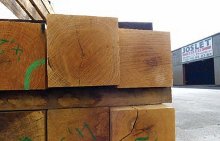Tour de France
4 August 2012The French Timber marketing organisation is spreading the word about the depth and diversity of France’s timber resource
Besides its wine and cuisine, France has a reputation worldwide for its timber. It is one of Europe's biggest producers and, with a third of its land area under forest, has one of the richest and fastest expanding wood resources on the Continent.
But its reputation in a much of the international market is probably limited to a few key species: mainly oak, plus, perhaps, ash and beech, and a few other hardwoods. But this only scratches the surface. France offers a staggering range of different varieties, and in substantial quantities. That includes softwoods. In the south-west maritime area it has one of Europe's biggest pine forests while, after almost constant growth since its introduction in the 19th century, it has the Continent's biggest resource of Douglas fir. France's Douglas fir forest now covers 390,000ha, comprising 63 million m3 of standing wood. It delivers 850,000m3 of sawn timber annually and is growing at 5% a year.
To raise awareness of the wealth and diversity of the timber sector, including its fast developing engineered wood and timber construction industries, since 2001 the French Timber marketing agency has hosted trade journalists from around the world, including the UK, on regular fact-finding trips. These
take in a range of leading and especially interesting businesses, and culminate every other year in a visit to the Carrefour International du Bois show in Nantes.
This year the tour focused on the south and west. It began with a visit to the Moulin Group in Dunière in the Haute Loire (www.moulinsa. com). The company's sawmill produces 180,000m3 of pine, spruce and Douglas fir lumber a year and also further processes this into a range of products. This includes dried, planed and pressure-treated wood, milled posts and timber frame structural components. It has also moved into solid timber wall panels.
Its substantial co-products output and the drive for green energy in France and abroad have also prompted Moulin to move into wood fuel. It produces electricity from a 3.3MW wood-fired boiler, with sales to the French grid earning €4m a year, and has built an 80,000-tonne capacity wood pellet plant.
Nearby Tecsabois operates on a smaller scale, but highlights France's other attraction to timber buyers: the diversity of its offer (www.tecsabois.com). The Coullons-based company, managed by Georges Saget, specialises in French oak, producing 40m3 of strips, edged timber and construction products a day and exporting 30% of output. A speciality is patented 'stabilised drilled oak' (bois percé stabilisé), billed as a structural component and designed particularly for chimney surrounds. The company has also ventured into thermal treating through its Tecsathermique subsidiary and started glulam square production.
The press party continued to Joslet, a company which, according to one of the journalists, Arief Odon editor of the Asian title Woodmag, has "great potential to export to Indonesian and Malaysian furniture makers" (www.joslet.fr).
The family-run company produces semi-finished products including planed, glued and profiled timber, using all PEFC-certified French oak, beech, ash, chestnut, acacia, poplar and softwoods.
"We are constantly exploring new ways of extracting the quintessential attributes and maximising the potential applications of oak and the other species available to us," said CEO Jean-Paul Joslet.
The journalists also visited a company at the other end of the scale - plywood giant Joubert (www.joubert-group.com), which has dual FSC and PEFC certification. It also manufactures products that comply with the US green building code LEED and describes itself as "your partner for green building products".
The company specialises particularly in plywood made from African okoumé. The range includes internal and external construction grades, primed varieties, marine plywood, veneer-faced decorative product, grooved, flexible and specialist fire- and insect-proof varieties and an insulating panel called rubberplex. The latter comprises a sandwich of hardwood on the exterior, a lighter, softer layer next, then a rubber core to provide both sound and thermal insulation.
Another recently launched range is exterior grade Primed 2, an FSC-certified CE2+ okoumé product designed for ease and speed of installation. This is coated in UV mastic to block the pores before being given a factory-applied 80 micron coating of white acrylic paint and a light sanding. The result, said Joubert, is a panel (250x122mm and 310x153mm) that can be installed and given a final coat of paint or varnish in one-and-a-half hours, compared with four-and-a-half for standard unfinished plywood.
Finally the journalists were shown latest examples and different sides of French timber construction. The first was a typical French building given a dramatic new slant; an old wine storage barn, transformed into a modern tasting facility with a trapezoid design featuring Douglas fir structurally and externally and beech internal decoration and cladding. The other was an all-timber swimming pool building in Tours, with all the material, inside and out, untreated and left to age and colour naturally. The curving 32m structural frame is again in Douglas fir, one of the species the French have in profusion, but is only now becoming known on the international market.
